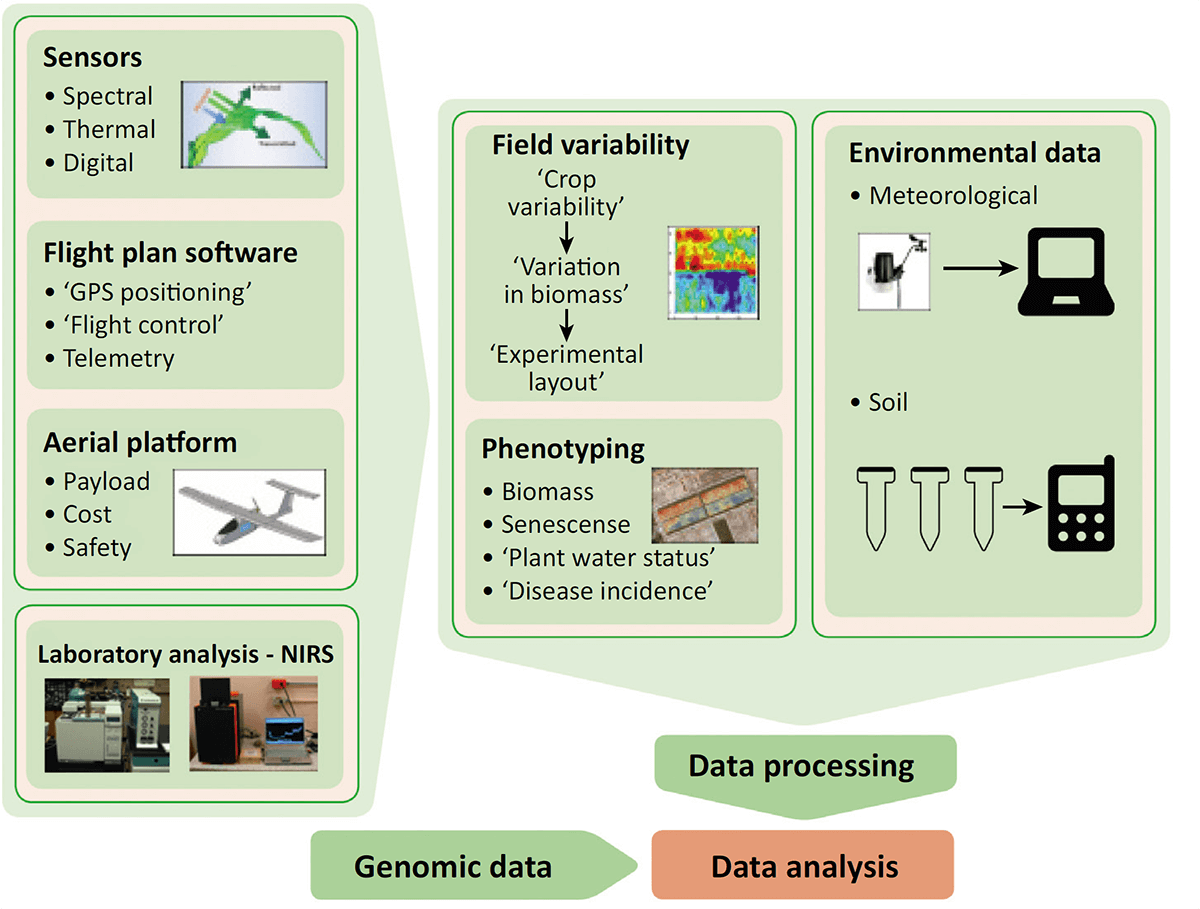Lifeasible, as a leading plant biotechnology company, has developed a state-of-the-art platform based on high-throughput plant phenotyping. This platform offers methods and techniques for automated trait sensing, data acquisition, and data analysis. High-throughput phenotyping (HTP) provides enormous value information for breeding, gene mapping, crop management, as well as insights into plant development and environment monitoring. Compared with manual phenotype measurements, HTP technologies not only saves large amount of labor and time, but also enables efficient data achievement with high number of samples, high temporal resolution, and high precision.
 Figure 1. The HTP platform involves evaluation of key traits at the right moment, assessment of spatial variability, environmental characterization, and comprehensive information integration (Araus and Cairns, 2014).
Figure 1. The HTP platform involves evaluation of key traits at the right moment, assessment of spatial variability, environmental characterization, and comprehensive information integration (Araus and Cairns, 2014).
At Lifeasible, the HTP platform provides high quality quantitative plant phenotype data under normal or stress growth conditions. These data cover a wide range of phenotypic characters, physiological parameters, as well as soil and environmental data, which include, but not limited to:
- Seed germination status.
- Plant stress response.
- Plant height.
- Photosynthesis rate.
- Stem diameter.
- Stomatal conductance.
- Leaf number and area.
- Water use efficiency.
- Tiller number.
- Transpiration rate.
- Flowering time.
- Drought critical point.
- Yield-related traits.
- Fertilizer uptake and optimization.
- Plant relative water content.
- Soil moisture.
- Plant architecture.
- Soil nutrient component.
- Plant biomass.
- Soil mechanical impedance and depth.
- Root phenotyping.
- Soil electrical conductivity.
- Root water Fluxes.
- UV and visible light intensity.
- Plant disease.
- Air temperature.
- Plant metabolic changes.
- Air relative humidity.
These data can be collected by employing a variety of sensors, including:
- Digital RGB imaging. RGB cameras allow for rapid and objective assessment of plant growth, architecture, seed germination, and disease screening. Vegetation indices derived from RGB images have been used for assessing genotypic differences in grain yield in response to a wide range of stress conditions including water stress, low nitrogen, heat, or biotic stresses.
- 3D laser scanning. 3D laser scanning techniques, including radio detection and ranging (Radar), as well as light detection and ranging (Lidar), allow measurements of plant architecture, canopy traits, and growth rates at high resolutions. Radar remote sensing uses the microwave portion of the electromagnetic spectrum, from a frequency of 0.3 to 300 GHz, while Lidar utilizes near infrared light (mostly 800-1000 nm).
- Thermal infrared (IR) imaging. Thermal IR cameras are reliable and scalable crop phenotyping instruments based on visualization of difference in temperature. This technique provides information about transpiration rate, leaf senescence, leaf/canopy temperature, water stress, disease and pathogen infection, and so on.
- Multi and hyperspectral imaging. By dividing each pixel of an image into wavelength bands, multi and hyperspectral imaging techniques allow capturing of electromagnetic radiation reflected from vegetation in the visible (400-700 nm), near infrared (700-1300 nm) and short-wavelength infrared (1400-3000 nm) regions. This technique is also applicable for assessment of leaf physiological status (e.g., photosynthetic efficiency and transpiration rate), water content, pigments, and structural components of biomass.
- Fluorescence imaging. Fluorescence imaging allows quantification of the light reemitted from the chlorophyll a photosynthetic pigment. It can provide information about the photosynthetic apparatus under abiotic and biotic stresses. When combined with thermal image techniques, fluorescence imaging also can be used for identification and quantification of fungal infections.
- Environmental sensors. Accurate environmental characterization throughout a growing season, including temperature, rainfall, radiation intensity, soil moisture, relative humidity, and day length, can be achieved using geographic information system (GIS) for crop monitoring.
- Others. Some techniques have been developed for root phenotyping like root depth and distribution. These techniques include excavation techniques, electrical capacitance, stable isotope analysis, and magnetic resonance imaging.
Lifeasible has developed a high-throughput, soil-plant-atmosphere-continuum based system that allows precise measurements for the whole-plant response to different environments. With the capability of real-time data collection and analysis from all plant samples throughout the entire growing season, this system ensures the delivery of highly accurate and repeatable data sets. Our customized high-throughput phenotyping services will accommodate the diverse requirements of our customers worldwide. You are welcome to contact us for technical consulting and collaboration.
Reference
- Araus, J. L.; Cairns, J. E. (2014). Field high-throughput phenotyping: the new crop breeding frontier. Trends in Plant Science. 19(1), 52-61.
For research or industrial raw materials, not for personal medical use!
 Figure 1. The HTP platform involves evaluation of key traits at the right moment, assessment of spatial variability, environmental characterization, and comprehensive information integration (Araus and Cairns, 2014).
Figure 1. The HTP platform involves evaluation of key traits at the right moment, assessment of spatial variability, environmental characterization, and comprehensive information integration (Araus and Cairns, 2014).